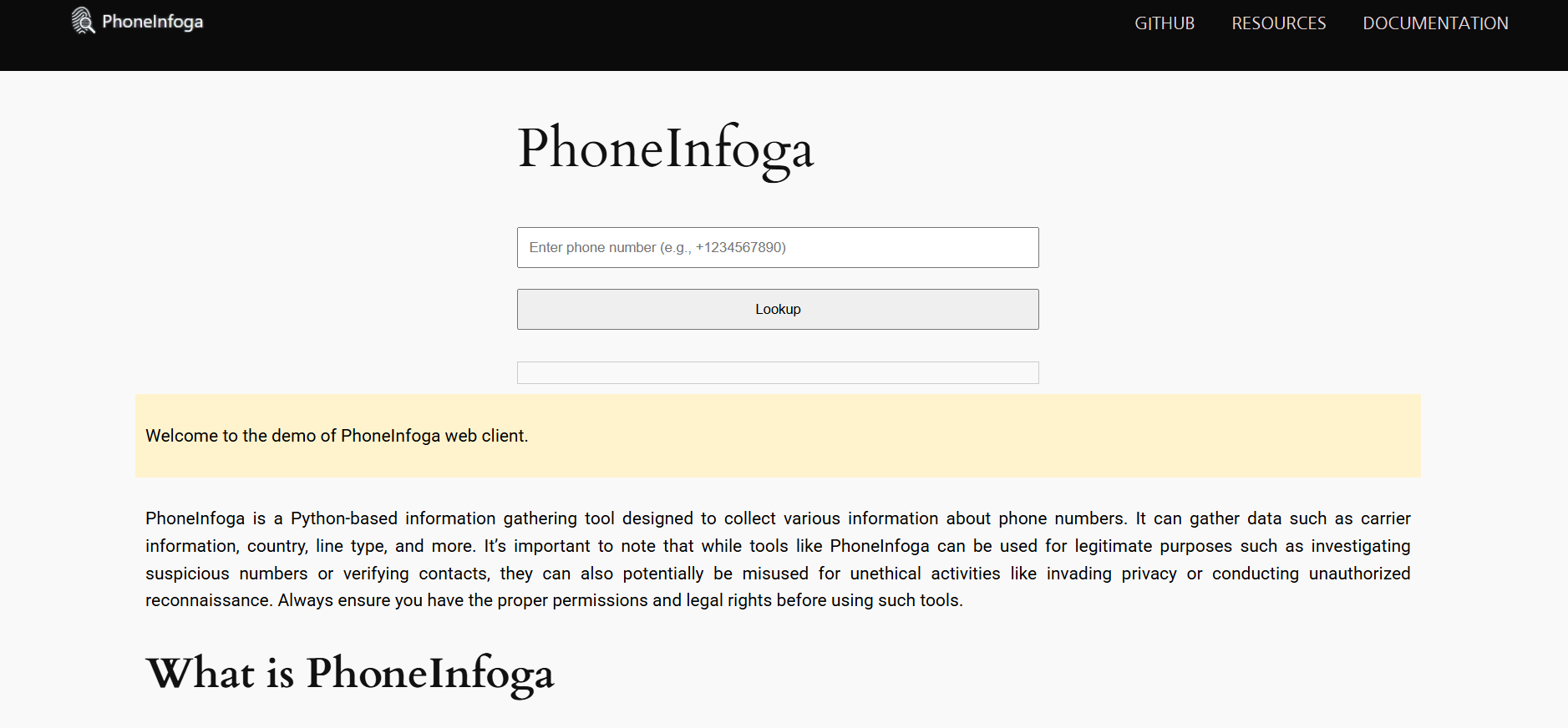Phone number tracking has become a critical task in today’s cybersecurity landscape. Whether it’s about detecting spam calls, uncovering scam operations, or conducting lawful investigations, the tools involved must be powerful, reliable, and efficient. One such tool gaining significant attention is PhoneInfoga, an open-source intelligence (OSINT) framework explicitly designed to collect phone number data for investigative or security purposes.
Unlike generic lookup services, PhoneInfoga provides far more comprehensive results. It leverages a range of techniques to pull carrier details, geolocation hints, and even linked online activity. This article explains how PhoneInfoga operates, how it gathers data, and how investigators and ethical hackers utilize it to track phone numbers online.
Designed for OSINT and Reconnaissance
PhoneInfoga isn’t just a simple number lookup tool—it’s a full-blown reconnaissance engine. Created by French developer Raphaël Hertzog and maintained within the open-source community, PhoneInfoga is tailored for cybersecurity professionals, digital investigators, and OSINT analysts.
The tool is built on Python and functions through a command-line interface (CLI), making it flexible for automation, integration, and advanced querying. PhoneInfoga doesn’t rely on a centralized database. Instead, it queries external sources and public databases in real-time, compiling insights from multiple endpoints to form a cohesive picture of the target number.
Initial Number Parsing and Validation
PhoneInfoga begins with parsing and validating the number using the libphonenumber library, a widely trusted utility by Google. This step is critical because not all phone numbers entered are well-formatted or even real.
Parsing allows the tool to extract the following basic data:
- Country of origin
- Number type (mobile, fixed line, VoIP, toll-free)
- Possible validity based on international formats
Validation doesn’t confirm if the number is currently active—it simply ensures the format matches known telecom standards. This early filtering phase helps avoid wasting time on fake or mistyped entries.
Leveraging Public and Semi-Public Data Sources
The power of PhoneInfoga lies in its multi-layered data-gathering strategy. After parsing, it initiates queries to open-source platforms and services, which may include:
- Google search dorks for online footprints
- Social media traces through linked usernames or mentions
- WHOIS lookups if the number is used in domain registration
- Carrier and line type detection
- National numbering plan analysis
- Third-party lookup APIs such as Numverify or OVH
PhoneInfoga doesn’t store the data; instead, it acts as a middleware that pulls and organizes it from elsewhere.
Identifying Carrier and Line Type
PhoneInfoga checks the telecom carrier associated with a number, which can give valuable context about its origin and purpose. Knowing the line type—whether it’s a mobile, VoIP, or landline—helps determine the likelihood of fraud or automation.
For example:
- Mobile numbers linked to known telecom brands may suggest legitimate ownership.
- VoIP numbers from services like Google Voice or Twilio could imply temporary or anonymous usage.
- Premium-rate or toll-free lines might indicate business or scam activities.
This analysis is particularly helpful in corporate investigations or anti-fraud measures.
Tracing Geolocation Data
While PhoneInfoga doesn’t provide pinpoint GPS tracking, it does extract approximate geolocation using national carrier data and regional telecom assignments. This works by checking:
- Number prefix and area codes
- Country-specific numbering patterns
- Geo-tagged online footprints tied to the number
It’s important to note that PhoneInfoga does not hack devices or trace real-time location. Its geolocation capabilities are based on inference, not active triangulation. Still, narrowing down the number to a city or region can significantly aid investigative workflows.
Querying Search Engines and Metadata
One of the most powerful features of PhoneInfoga is its ability to perform Google search dorks and metadata-based queries. It automates this process by constructing targeted search patterns, such as:
- “123-456-7890” site:facebook.com
- “call me at 1234567890” intext
These searches are invaluable in identifying:
- Usernames and online profiles
- Forum discussions or leaked databases
- Websites where the number is publicly listed
- Business or service listings
In essence, PhoneInfoga helps connect a number to a digital footprint, revealing where and how it’s been used online.
Integration with External APIs and Custom Modules
For advanced users, PhoneInfoga can integrate with external APIs for deeper analysis. These integrations allow:
- Enrichment through paid services (e.g., Truecaller, Numverify, Twilio Lookup)
- Custom modules for niche queries
- Automated workflows using Python scripts or Docker setups
Investigators and ethical hackers often build custom configurations on top of PhoneInfoga to expand its range, especially for region-specific lookups or regulatory environments.
Use Cases in Security and Investigation
PhoneInfoga’s capabilities extend far beyond curiosity. It plays a real-world role in multiple professional and ethical domains:
Cybersecurity and Threat Intelligence
PhoneInfoga aids in identifying suspicious numbers linked to phishing or social engineering attacks. By mapping out a user’s online activity, security teams can detect spoofing attempts, call fraud, or impersonation scams.
Law Enforcement and OSINT
Investigators can trace burner phones, spam callers, or suspicious domains that use traceable phone numbers. In missing person cases, it can help correlate numbers with public social profiles.
Business Verification
Companies use PhoneInfoga to vet vendors, clients, or potential partners by checking whether the provided numbers have any fraudulent or suspicious background online.
Journalism and Research
Reporters and researchers often rely on tools like PhoneInfoga to confirm the authenticity of whistleblower tips or leaked documents.
Legal and Ethical Considerations
Despite its powerful features, PhoneInfoga is strictly limited to public and semi-public data. It does not access private databases, wiretap calls, or compromise devices. Still, ethical and legal boundaries must be respected.
Important guidelines:
- Always get consent or use the tool within your organizational policy.
- Avoid harassment or unauthorized tracking.
- Never use PhoneInfoga for personal revenge or illegal activity.
Violating these principles could result in criminal charges, even if the data is public.
Benefits of Generic Lookup Services
PhoneInfoga provides a level of flexibility and transparency that paid number lookup tools don’t offer. Key advantages include:
- Open-source nature, meaning full auditability
- Custom integration into larger recon pipelines
- No paywalls or limitations on queries
- Compatibility with CI/CD systems for automation
- Access to real-time OSINT sources, unlike static databases
It’s particularly useful in enterprise security teams looking for a free, scalable solution for phone intelligence gathering.
Limitations to Consider
While PhoneInfoga is powerful, it’s not magical. Some notable limitations:
- Doesn’t access private user databases (e.g., WhatsApp contacts, telecom backends)
- Limited accuracy for unlisted or burner numbers
- Geolocation is approximate, not GPS-based
- Heavy reliance on the avathe ilability of open data
In short, PhoneInfoga shines when supplemented with human analysis and other tools, not as a sole solution.
Future of Phone Number Intelligence
As digital footprints expand, tools like PhoneInfoga will likely evolve to include machine learning, graph visualizations, and multi-lingual search capabilities. The OSINT community is already developing enhancements and alternative data connectors to make phone tracking even more seamless.
New modules may also offer dark web scanning, VoIP fraud detection, and real-time alerting, turning PhoneInfoga into a central part of the modern investigator’s toolkit.
Final Thoughts
PhoneInfoga provides a sophisticated, ethical approach to tracing phone numbers online using OSINT techniques. From uncovering telecom origins to detecting online mentions and public records, it empowers cybersecurity professionals, journalists, and investigators with the intelligence needed to understand who is behind a number—and why it matters.







